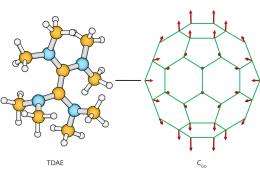The origin of organic magnets

Electrical engineers are starting to consider materials made from organic molecules -- including those made from carbon atoms -- as an intriguing alternative to the silicon and metals used currently in electronic devices, since they are easier and cheaper to produce. A RIKEN-led research team has now demonstrated the origin of magnetism in organic molecules, a property that is rarely found in this class of material, but is vital if a full range of organic electronic devices is to be created.
The permanent magnetic properties of materials such as iron stem from an intrinsic mechanism called ferromagnetism. Ferromagnetism in organic materials is rare because their atomic structure is fundamentally different from metals. One of the few examples identified to date is called TDAE-C60: a compound comprising spherical carbon cages attached to an organic molecule known as tetrakis-dimethylamino-ethylene (Fig. 1). Since its identification in 1991, many theoretical and experimental studies have provided some insight into the mechanism driving this unexpected ferromagnetism, but the explanation was not definitive. A full understanding would help materials scientists to develop more advanced magnetic materials in the future. “A precise model for organic magnetism could aid the design of high-density recording materials for use in next-generation memories,” says team member Hitoshi Yamaoka from the RIKEN SPring-8 Center, Harima.
Materials scientists are particularly interested in understanding the electronic structure of TDAE-C60 and how this relates to its ferromagnetic properties. To this end, Yamaoka and his colleagues from research institutes across Japan studied this material using a powerful technique known as photoelectron spectroscopy (PES). They fired x-rays at a single crystal of TDAE-C60, and this radiation excited electrons in the crystal, which then escaped from the surface. The researchers measured the number and the kinetic energy of these electrons from which they could infer information about the electronic structure.
“From these experiments on a single crystal we could establish an exact theoretical model for organic magnetism,” explains Yamaoka. “We propose that the transfer of one electron from the TDAE to the C60 causes the magnetic properties of TDAE-C60.” The existence of the resulting positively charge TDAE state was also supported by the team’s theoretical calculations.
With this thorough understanding of organic magnetism, the next step will be to apply the material to practical applications. “The problem with the TDAE-C60 organic magnet, however, is that the magnetism only appears at temperatures below 16 kelvin,” says Yamaoka. “The next step will be to raise this transition point.”
More information: Yamaoka, H., et al. Electronic state of an organic molecular magnet: Soft x-ray spectroscopy study of α-TDAE-C60 single crystal. Physical Review B 84, 161404 (2011).
Provided by RIKEN




















